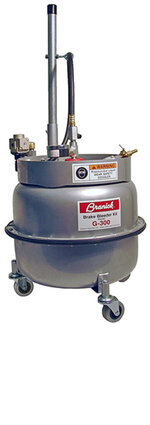I normally avoid using my pneumatic vacuum brake bleeder for fluid exchanges since it results in a soft brake pedal. For some reason, the vacuum bleeder will often allow a small amount of air to enter the brake caliper.
I recently found that if you allow each caliper to gravity bleed for at least one min, most of the trapped air will come out.
I made a video of the process. In this video, you will see me turn off the pneumatic brake bleeder and remove the collection hose. After removing the hose (0:03), it takes about 15 seconds (0:18) before fluid begins to drip out of the bleeder screw - this is due to the trapped air inside of the caliper. As fluid drips, you may be able to see a small air bubble at the opening of the bleeder screw. After about 30 seconds of dripping (0:52), the bubbles disappear.
Does it work? Sort of - the pedal still ends up a bit softer than before I completed the service. It did seem to firm up a bit after the test drive, so perhaps the vacuum process causes the fluid to aerate a bit?
I recently found that if you allow each caliper to gravity bleed for at least one min, most of the trapped air will come out.
I made a video of the process. In this video, you will see me turn off the pneumatic brake bleeder and remove the collection hose. After removing the hose (0:03), it takes about 15 seconds (0:18) before fluid begins to drip out of the bleeder screw - this is due to the trapped air inside of the caliper. As fluid drips, you may be able to see a small air bubble at the opening of the bleeder screw. After about 30 seconds of dripping (0:52), the bubbles disappear.
Does it work? Sort of - the pedal still ends up a bit softer than before I completed the service. It did seem to firm up a bit after the test drive, so perhaps the vacuum process causes the fluid to aerate a bit?

